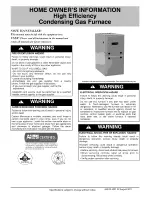
9
Thermostat Location
The thermostat should be placed approximately five feet
from the floor on a vibration-free, inside wall in an area
having good air circulation. Do not install the thermostat
where it may be influenced by any of the following:
•
Drafts, or dead spots behind doors, in corners, or
under cabinets.
•
Hot or cold air from registers.
•
Radiant heat from the sun.
•
Light fixtures or other appliances.
•
Radiant heat from a fireplace.
•
Concealed hot or cold water pipes, or chimneys.
•
Unconditioned areas behind the thermostat, such as
an outside wall.
Consult the instructions packaged with the thermostat for
mounting instructions and further precautio
ns.
COMBUSTION & VENTILATION
REQUIREMENTS
WARNING
To avoid property damage, personal injury or death,
sufficient fresh air for proper combustion and ventilation
of flue gases must be supplied. Most homes require outside
air be supplied into the furnace area.
Improved construction and additional insulation in buildings
have reduced heat loss by reducing air infiltration and
escape around doors and windows. These changes have
helped in reducing heating/cooling costs but have created
a problem supplying combustion and ventilation air for
gas fired and other fuel burning appliances. Appliances
that pull air out of the house (clothes dryers, exhaust
fans, fireplaces, etc.) increase the problem by starving
appliances for air.
House depressurization can cause back drafting or
improper combustion of gas-fired appliances, thereby
exposing building occupants to gas combustion products
that could include carbon monoxide.
If this furnace is to be installed in the same space with
other gas appliances, such as a water heater, ensure there
is an adequate supply of combustion and ventilation air
for the other appliances. Refer to the latest edition of the
National Fuel Gas Code NFPA 54/ANSI Z223.1 or CAN/
CSA B149.1-15 Installation Codes or applicable provisions
of the local building codes for determining the combustion
air requirements for the appliances.
Most homes will require outside air be supplied to the
furnace area by means of ventilation grilles or ducts
connecting directly to the outdoors or spaces open to the
outdoors such as attics or crawl spaces.
INSTALLATION POSITIONS
Figure 2A
Figure 2B
Figure 2C
Figure 2D
Recommended Installation Positions










































